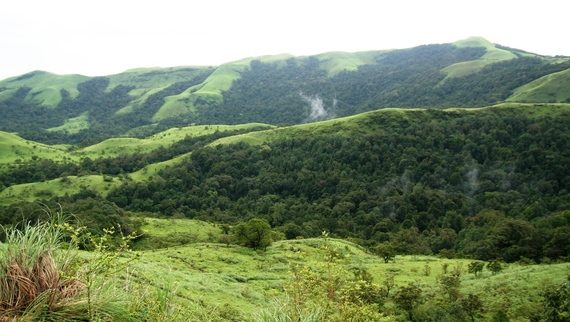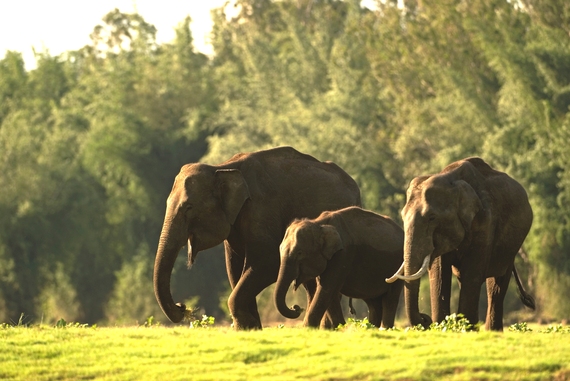What does Narendra Modi's emphatic win portend for India's natural riches? Covering just 2.2 percent of Earth's land, India harbors close to 13 percent of Earth's bird species, 7 percent of mammals, 5 percent of reptiles and 4 percent of amphibians. Of the 240 species of living carnivores, 25 percent occur in India. Imagine any single country in which tigers, lions, elephants, rhinos, brown bears, elk, wolves, and hyenas all roam free.
These natural riches are compellingly summed up as "our bountiful mother nature, clad in deep greenery" in the nationalist lyric Vande Mataram, which was Modi's rallying call in his march to power.
The rugged slopes of the Western Ghats are blanketed in dense rainforests that are home to thousands of unique plant and animal species (photo © Rohit Rao).
Seventy million years ago, gigantic continental plates broke apart and rammed each other, causing the mighty Himalayas to erupt. The sacred river Ganga flowed a few million years later. India's exceptional biodiversity results from such ancient accidents of geology and evolution.
In contrast, humans arrived only 60,000 years ago and spawned the Hindu culture a mere 3,000 years ago. That culture was more deeply inspired by wild nature than any other on Earth. Unlike Western creeds, Hinduism does not believe other species were created only to meet human needs. Such an affirmation of the intrinsic right of other species to exist is a precursor to the modern idea of species conservation.
The social tolerance emerging from this tenet is a primary reason why threatened wildlife species continued to survive in the Hindu heartland well into the 20th century, even as they were being extirpated elsewhere.
More than two decades of conservation work in Nagarahole, India, has led to a tiger population increase of 400 percent (photo © Kalyan Varma).
Hopefully, Mr. Modi will recognize that the fragile nature he holds in temporary custody is a product of millions of years of evolutionary Karma. Grandmother Nature gave birth to Mother India, whom he has sworn to serve.
Modern science recognizes that protecting biodiversity must become integral to the economic development process if it is to be sustainable. This idea is accepted universally in theory and flouted widely in practice. India is no exception. During his campaign Modi shrewdly articulated goals of "security and development" to overcome portrayals of him as just another religious zealot.
Most observers believe achieving the right balance between economic growth and social harmony will be Modi's biggest challenge. Conserving India's nature will be an even harder challenge. Over a billion citizens will loudly demand the "security and plenty for all" that he promised. Grandmother Nature will suffer in silence.
Dholes are Asiatic wild dogs found in India and other parts of South and East Asia (photo © Center for Wildlife Studies)
If he accepts that challenge, Modi faces a grim reality: Nature reserves occupy less than 5 percent of India. Beyond these last refuges of globally threatened species lies an additional 10 percent of the nation's land with degraded forest cover and sparse wildlife. Even these fractured natural remnants are under a pincer attack.
The adverse impacts of modern development from mines, dams, and industry are well recognized. However, even more widespread negative impacts of rural communities are shielded by a conspiracy of silence among many "greens" in India.
As the first politically viable prime minister to emerge from India's subaltern castes, Modi embodies their work ethic and common sense. It should be clear as daylight to him that sacrificing this 5 to 10 percent of Indian land harboring remnants of nature cannot even make a dent in resolving the huge problems of growth, equity, and historical injustices.
The WCS India program has conserved the largest wild Asian elephant population -- more than 5,000 animals in the Western Ghats of Karnataka and adjacent areas (photo © Kalyan Varma).
How much better off would Modi's native Gujarat have been today if a hundred years ago the Nawab of Junagadh had decided to kill off the last wild lions and farm their habitats, as other rulers around him were doing?
If Modi decides to secure wild India, in practical terms the path is clear: The network of nature reserves must be scientifically redefined, expanded, and perpetuated as "sacred groves" for the 21st century and beyond. This means strengthening the conservation laws enacted by former Prime Minister Indira Gandhi.
These laws have been chipped steadily away by all her successors. Populist acts of the United Progressive Alliance, which Modi dethroned, contributed significantly to the weakening of nature conservation in India.
The gaur, sometimes referred to as the "Indian bison," is a forest-dwelling bovine species found across South and Southeast Asia (photo © K. Ullas Karanth).
If the political strongman Modi is to rebuild the foundations of India's ecological security, he has to marshal all his inner strengths: tolerance inherent to his Hindu faith, personal experience of poverty, trust in nongovernmental creativity, appreciation of technology, and skill at governing.
Modi can do this only if he recognizes that he cannot serve Mother India unless he takes care of Grandmother Nature too.





